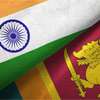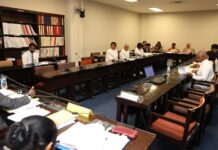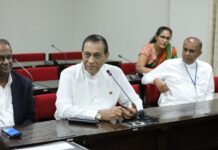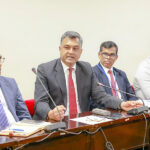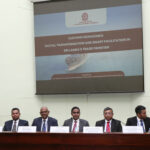In an attempt to boost connectivity with each other, neighbours India and Sri Lanka to go ahead with two connectivity proposals which are considered key in enhancing people-to-people connectivity especially between the Northern region of Sri Lanka and Tamil Nadu.
Sri Lanka, which is going through its worst economic crisis, approved the two proposals this week.
According to Sri Lanka’s Fisheries Minister Douglas Devananda, who is based in the Northern region, a Memorandum of Understanding (MoU) was signed on 13 June to resume flights between Jaffna International Airport in Palaly and Tiruchirappalli Airport in Tamil Nadu.
Meanwhile, a ferry service would be launched between Kankesanthurai, Jaffna in Northern Sri Lanka to Karaikal in Puducherry, a Union Territory in Tamil Nadu, India as the second connectivity project.
The proposal for the ferry service has long been on the cards. Union Minister for Health and Family Welfare of India Mansukh Mandaviya also commented on the project last year. Minister Mandaviya in a tweet said he met with officials over the proposal and that it will ensure easy and cheap connectivity, thereby enhancing various economic activities between the two neighbours.
Similarly, Chairman of Jaffna District Development Committee MP Angajan Ramanathan tweeted early last year and said that the MoU was signed between Sagarmala Development Company Limited and INDSRI Ferry Services Pvt Ltd for Passenger Shipping Service from Kankesanthurai or KKS Port to Karaikal Port and the sea connectivity between India and Sri Lanka will strengthen bilateral relations.
However, Minister Douglas Devananda told media after the Cabinet approval was granted to the project this week that the subject minister will study the proposal and then forward it to President Gotabaya Rajapaksa. “The process should begin by next month,” he said.
Commenting on the resumption of flights from Jaffna to Puducherry, Minister Devananda said the flights would launch as soon as refurbishment works of the airport are completed, and once the Immigration and Customs services are revived.
The northern region of Sri Lanka which was the most affected area during the three-decade long civil war was in need of much stronger connectivity to uplift the livelihood of the people there and to improve the devastated infrastructure facilities. Once the war between the Sri Lankan Government and the LTTE came to an end in 2009, many plans were initiated to improve connectivity to the North from other parts of the country and also to improve infrastructure in an attempt to open up the region.
While these projects were being implemented, plans were afoot to connect the Northern region with South India as well. However, the project to launch flights from Jaffna to Chennai operated by Alliance Air was not materialised until November 2019, only to be suspended amidst the COVID-19 pandemic that broke out soon after.
Meanwhile, former Tourism Minister of Sri Lanka Prasanna Ranatunga in January this year said a tripartite agreement would be signed among the Airport and Aviation Company, the Civil Aviation Authority of Sri Lanka (CAASL) and the Sri Lanka Air Force to develop the Batticaloa Airport in Eastern Sri Lanka as a fully-fledged domestic airport.
He opined that the development would enable quick access to the Eastern Province for both local and foreign tourists and investors and that the CAASL was drafting the agreement. Interestingly, the then Minister said discussions were underway with both local and Indian airline companies to resume flights this year.
The traditionally friendly and warm bilateral relations between the two countries that were seemingly sour until a few months ago have turned warm and much more engaging recently, especially with India coming to the rescue of Sri Lanka as it is facing its worst economic nightmare at the moment. The newly appointed Prime Minister of Sri Lanka Ranil Wickremesinghe who replaced Mahinda Rajapaksa after he resigned due to strong opposition by the people facing hardships, said the relations with India will be “much better.”
Meanwhile, Sri Lanka’s relationship with China seems to have hit a snag as the former has taken a backseat– as if to give India a more key role to play–when actively helping Sri Lanka to overcome its economic challenges.
Chinese Foreign Ministry Spokesperson Zhao Lijian said last week that China ‘commends’ India for efforts to mitigate the crisis in Sri Lanka.
“We have taken note that the Indian Government has also done a lot in this regard. We commend those efforts. China is ready to work with India and the rest of the international community to help Sri Lanka and other developing countries experiencing difficulty to pull through the hardship as early as possible,” Lijian said.
He said the Chinese Government will do its utmost and make full use of the channels available to deliver help to Sri Lanka.
Last week, Sri Lankan Premier Wickremesinghe said in Parliament that India was the only country that gives money to Sri Lanka for fuel. “No country is giving us money for fuel and coal. Only India is giving. Our Indian credit line is now nearing its end. We are talking about extending it,” he said.
In late May, Indian High Commissioner in Colombo Gopal Baglay handed over a consignment comprising of 9,000 metric tons of rice, 50 metric tons of milk powder, and over 25 metric tons of drugs and other pharmaceutical supplies to Sri Lanka.
Soon after the economic crisis hit Sri Lanka, Indian External Affairs Minister S. Jaishankar visited the country and said on March 30 that the Indian system is working ‘overtime’ to expedite its assistance to Sri Lanka.
“In a situation like this, things cannot be done at a normal pace. Everything must be fast-tracked. Our system is working overtime. What would have taken weeks earlier is now taking days,” he said.



